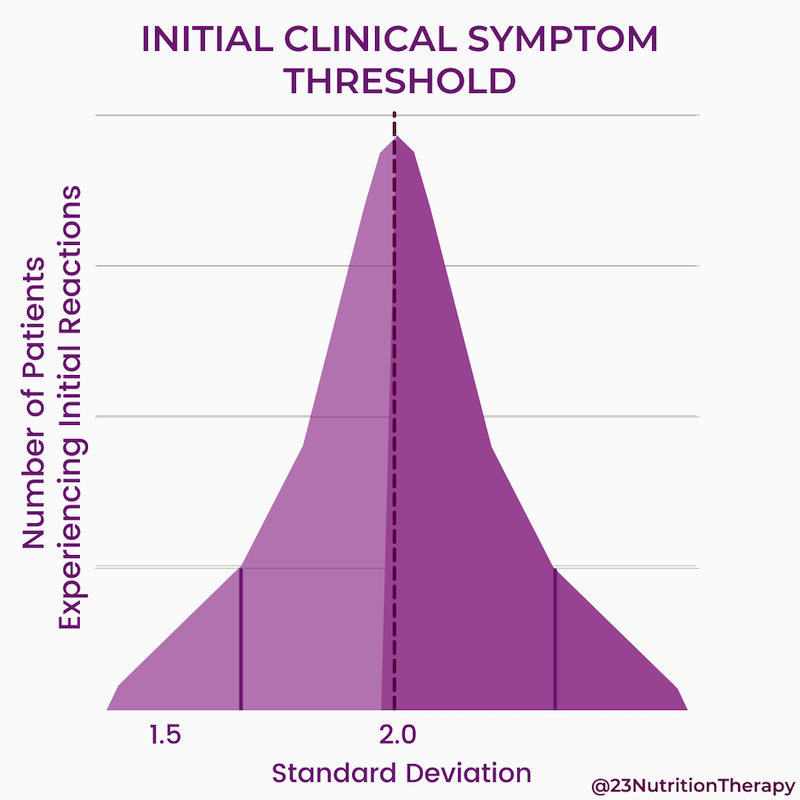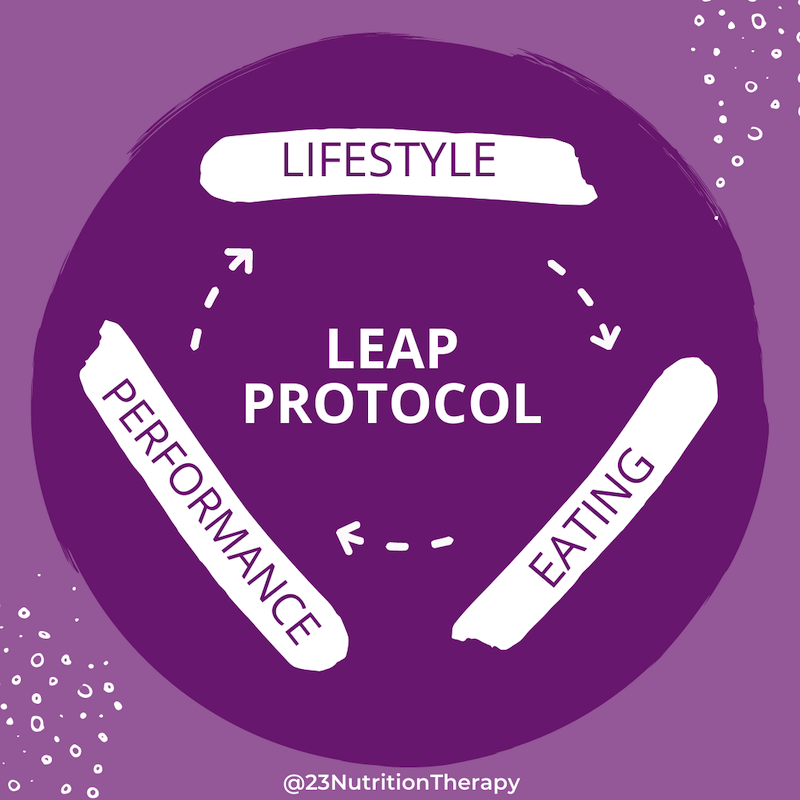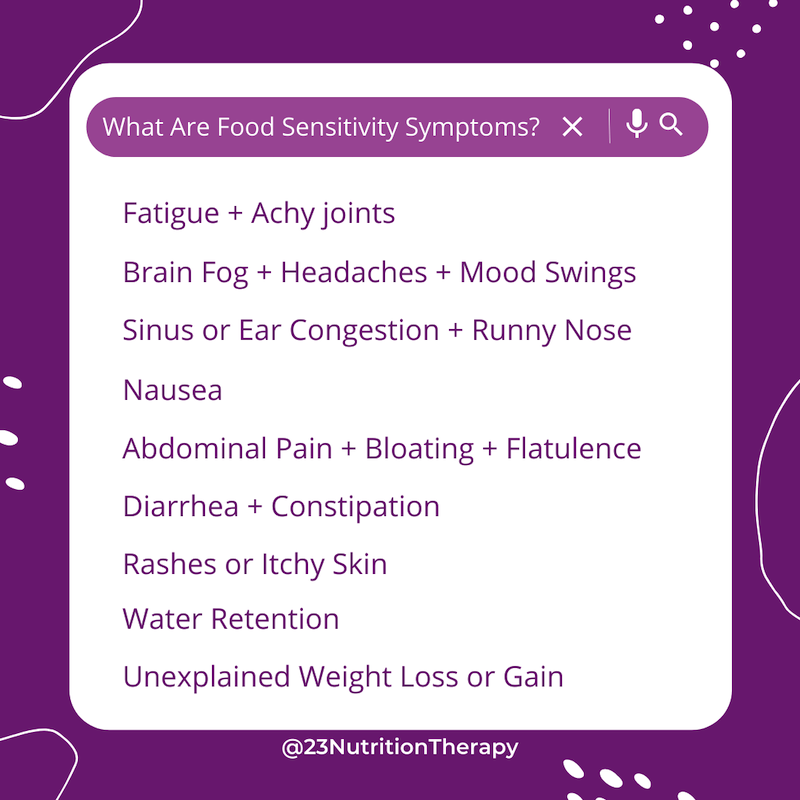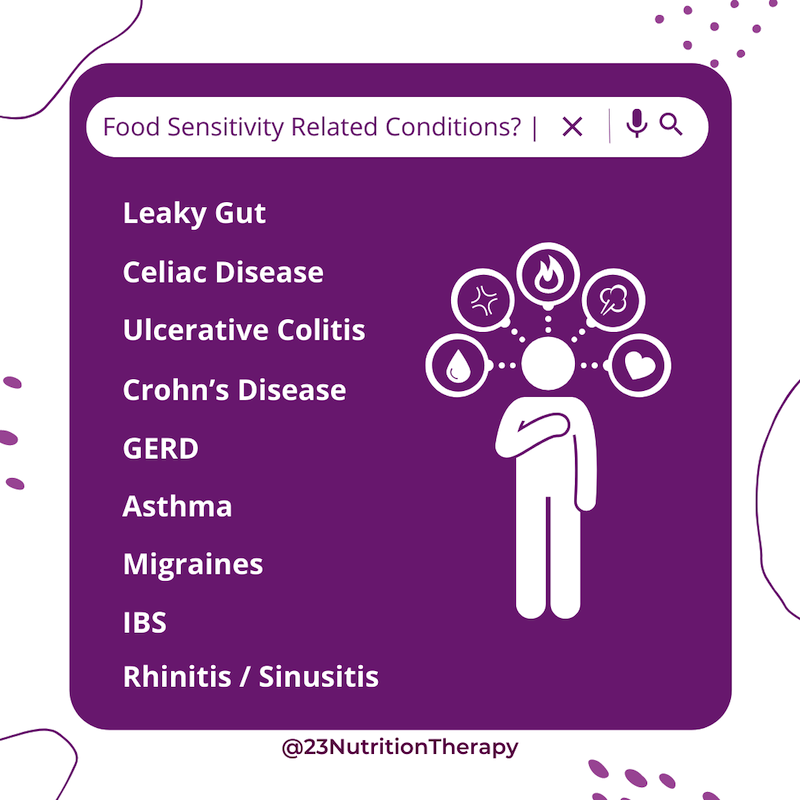Since you’re reading this, you may be dealing with uncomfortable post-meal symptoms and are trying to find out the cause. This article will walk you through our favorite method to test for food sensitivities: MRT food sensitivity testing.
With so many foods and chemicals available today, chances are you have experienced unpleasant symptoms after a meal but can’t pinpoint the exact cause. While these symptoms are not typically life-threatening, they can disrupt your life with uncomfortable symptoms. This is because the body’s immune reaction generates feelings of fatigue, bloating, gas, stomach pain, brain fog, and more.
While one common recommendation for food sensitivities is doing an elimination diet and keeping a food journal; this approach can often be tedious and not reliable. Think about it… If your food sensitivity is due to a chemical used in a particular food, there is no way you can detect that specific chemical from an elimination diet alone. This is why I want to introduce to you the Mediator Release Test (MRT). This article will explain to you why this combo of MRT coupled with the LEAP protocol (Lifestyle Eating And Performance) is highly effective at detecting personalized food sensitivities.
Inflammation and Food Sensitivities
 In the broad sense, food sensitivity refers to the body’s adverse reaction to specific food or chemical antigens (also known as a toxin or foreign substances) causing negative physiological effects within the body. The term “food sensitivity” specifically refers to a delayed, dose-dependent, adverse reaction to food.
In the broad sense, food sensitivity refers to the body’s adverse reaction to specific food or chemical antigens (also known as a toxin or foreign substances) causing negative physiological effects within the body. The term “food sensitivity” specifically refers to a delayed, dose-dependent, adverse reaction to food.
In simpler terms, your uncomfortable symptoms occur a while after consumption and also depend on how much you eat. This physiological reaction involves the immune system’s white blood cells (WBCs) and functions in the production of inflammatory mediators that ultimately cause the symptoms of food sensitivities.
Release of Mediators Lead to Food Sensitivities and Inflammation
In short, when we eat foods or chemicals that our bodies are sensitive to, our WBCs will be triggered to release various mediators such as histamine, cytokines, prostaglandins, leukotrienes, and up to 97 others into the bloodstream. As a result, the mediators that are released into the bloodstream usually cause subtle, unpleasant, or disruptive symptoms throughout the body.
To put this concept into perspective, a common food sensitivity is gluten. Gluten sensitivity often causes abdominal pain, bloating, diarrhea, and brain fog after consuming moderate amounts. What’s most important to recognize from this example is that the mediators that are released are not localized to a single organ. But rather, they circulate throughout the body causing a multitude of symptoms.
With that said, you may have experienced a similar situation, which can be very frustrating when trying to figure out exactly what is causing your symptoms. Luckily, a test known as the mediator release test (MRT) can be very helpful with determining not only if your symptoms are food-related, but also identifying specifically which foods or chemicals are the root cause.
Why Test MRT?
Now that we know what mediators are, how they are released, and what functions they have on our body, it makes sense that the most accurate food sensitivity test would focus on mediators. The test that we use to test food sensitivities is called the mediator release test (MRT). This test involves drawing blood (at a facility or with a mobile phlebotomist) and then having that blood sample shipped overnight to a lab. Once in the lab, it will be divided and mixed with high-quality freeze-dried food/chemical antigens that are tested on the MRT panel.
The next step of the MRT food sensitivity test is to analyze the mixed-blood samples by using the technology of flow cytometry and impedance technology to measure the liquid-to-solid ratio. What this means is that when a WBC reacts to a certain food antigen found within the mixture, there will be an increased amount of mediators released from the WBC which ultimately causes the WBC to shrink in size. While this food antigen response is a normal physiological process that constantly happens within the body, when a food sensitivity is detected, the WBC mediator’s response actually reacts in the form of a threat and is elevated to much higher levels than normal.
How Does MRT Food Sensitivity Testing Work?
The good news is these mediator response levels are exactly what MRT food sensitivity testing assesses. The test will quantify the level of food and chemical reactivity in the form of a standard deviation bell curve for your functional medicine practitioner or certified LEAP therapist to better analyze. The goal is to choose the lowest inflammatory foods while providing a balanced diet with a variety of foods. How it works is the standard deviation graph values represent a bell curve ranging from 0.0 to 2.0. Within those values, any food item with a reactive value of 0.0 will have a negligible bar graph, 0.5 is ¼ of the way up the “green” bar graph, 1.0 is halfway across, 1.5 is ¾ of the way across, and 2.0 is the highest level of the bar graph.

While manifestations of symptoms are most commonly seen after the 2.0 threshold, individual variations occur. For example, some people may have symptoms from foods slightly below 2.0. Others might not notice symptoms until the reactions are in the “yellow” range. In other words, food choices should ideally consist of items that have a reactive value of 1.0 or below. However everyone’s body is unique, and as mentioned before, food sensitivities are both dose- and frequency-dependent.
Therefore, with the help of your functional medicine dietitian and certified LEAP therapist, you will better understand your personal threshold with the results from the standard deviation graph and use it in your lifestyle, eating, and performance (LEAP) protocol. With the LEAP protocol, you will work to formulate a customized diet plan to meet your individual needs while avoiding foods or chemicals that are triggering.
MRT Food Sensitivity Testing Reliability
Why did I say the MRT blood test is the most accurate? Well, compared to other food sensitivity tests that are outdated or focus on only one sensitivity metric like IgG antibodies, the MRT is highly reliable due to its capacity to measure the exact cause of food sensitivities in the form of all mediators and antibodies released.
In addition, the MRT blood test is very accurate with a sensitivity rating reaching 95% and a specificity of 92%. (1) Likewise, MRT has proven to have a reproducibility constant of 90% of the time. In other words, out of every 10 people being tested, 9 of them will consistently obtain the same lab results. This helps eliminate false-positive discrepancies.
Why do I Have So Many Food Sensitivities?
One thing to know about adverse food reactions is about 50 to 90% are actually due to sensitivities or intolerances. (1) In fact, one major cause of food sensitivities is actually occurring because of poor gut barrier function aka “leaky gut”. Leaky gut occurs due to irritants such as food antigens (gluten for example) causing an inflammatory response on the gastrointestinal lining leading to mucosal tissue damage.

What this means is through the inflammatory response these food antigens destroy our intestinal villus which is the absorption site of our nutrients. It also means this inflammatory response is downregulating the gut’s first physical barrier of defense against pathogens, parasites, bacteria, and yeast known as the secretory immunoglobulin A (SIgA). Lastly, it means the inflammatory response is causing an erosion of the gut barrier’s tight junctions allowing for large undigested molecules in our bloodstream. (2) If you find you have many food sensitivities, the best place to start is healing the gut lining with a gut cleans diet by working with a functional medicine dietitian who is LEAP certified.
Why do Food Sensitivities Matter?
Without our villi properly absorbing nutrients and without SIgA protecting us from these pathogens, the gut’s permeability through tight junctions allows for undigested food and other toxins into our bloodstream which further perpetuates the inflammatory response. Remember what happens when we have an inflammatory response? White blood cells come to the scene and ultimately release our not-so-friendly friends, the mediators.
As mentioned before, the mediator response is not localized to a single organ and ultimately leads to uncomfortable symptoms and various disease states. Likewise, because the villi are not properly absorbing our nutrients we can also become malnourished, contributing to additional signs and symptoms.
The good news is this can be prevented with an MRT by identifying any food sensitivities and eliminating them through the diet. Next, you can begin repairing the leaky gut with the help of a functional medicine practitioner or certified LEAP therapist by incorporating any supplementation into your LEAP protocol if necessary.
So, if you believe food may be contributing to your symptoms and you are having trouble pinpointing the root cause, a food sensitivity test might be beneficial for you. If you are wondering how some of these food sensitivities manifest, the following symptoms and conditions are a good indicator you may be dealing with food sensitivity and MRT food sensitivity testing might be right for you.
Food sensitivity symptoms can include:
- Fatigue, achy joints
- Brain fog, headaches, mood swings
- Sinus or ear congestion, runny nose
- Nausea, unexplained weight loss or gain
- Abdominal pain, bloating, flatulence
- Diarrhea, constipation
- Rashes or itchy skin
- Water retention
Food sensitivity-related conditions can include:
- Celiac disease
- Ulcerative colitis
- Crohn’s disease
- GERD
- Asthma
- Migraines
- Leaky Gut
- IBS
- Rhinitis/Sinusitis
What is the LEAP Diet Protocol?

LEAP stands for lifestyle, eating, and performance diet protocol. The LEAP protocol as briefly talked about is based on the information provided by your MRT food sensitivity testing results, and is used as the new foundation to health and recovery. Unlike a typical elimination diet and food journal; the LEAP protocol entails a multiphase approach (usually 3 phases total) with an initial immuno-calm phase to drastically reduce inflammation. This is then followed by the incorporation of safe foods while temporarily eliminating sensitive foods.
Therefore, with the help of a functional medicine dietitian who is certified as a LEAP therapist, the LEAP protocol is used to selectively expand on acceptable food options to ultimately develop a flexible and nutrient-dense food plan that is free from adverse food reactions. Depending on your case, you may also be given lifestyle strategies to minimize symptoms, repair your digestion, and restore your gut health.
What’s Next?
If you’re tired of not feeling your ultimate best, and feel like any of the symptoms or conditions I provided relate to you, then it’s time to let the science talk. With MRT food sensitivity testing, not only will you obtain personalized results, but with the help of a functional medicine dietitian and certified LEAP therapist, you can begin enjoying food again without the fear of adverse food reactions.
LEAP Immunocalm diet package and mediator release test cost?
Take the LEAP symptom assessment to determine if LEAP is something that could work for you! If you find that you are scoring high, you may need to Schedule your appointment today to speak with a LEAP dietitian and begin your journey to wellness!
Resources





